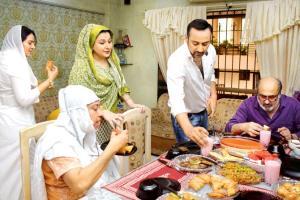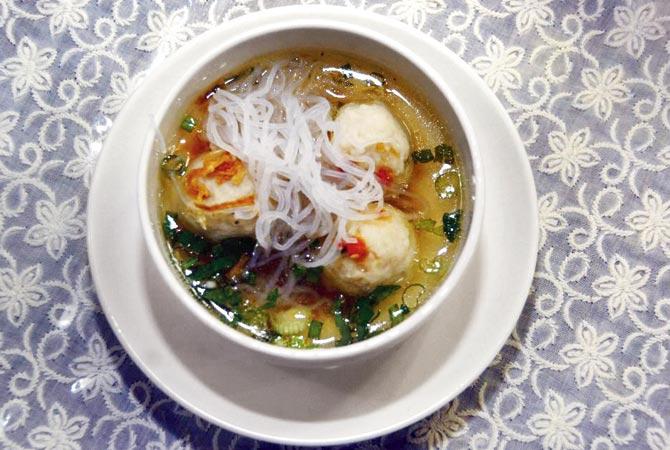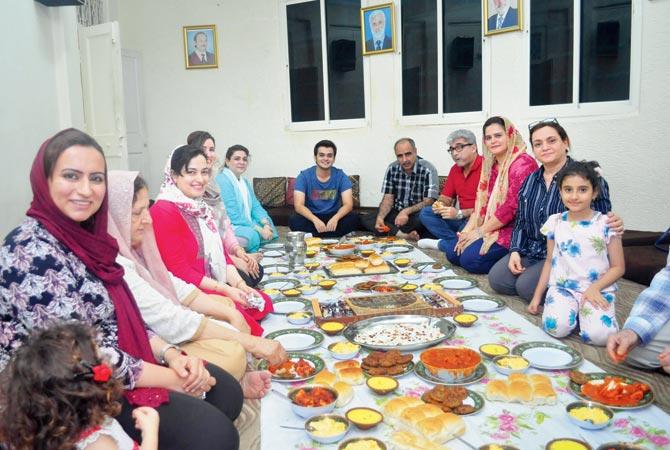Foodies from Iran, Indonesia and Saudi Arabia, who've made this city their home, tell Anju Maskeri and Jane Borges how they celebrate the holy month of Ramzan

Nadia Saudagar (in green) and her husband Mohammed Altamash with their family during iftar at their Oshiwara home. Pic/Ashish Raje
'In Saudi Arabia, Ramzan is about prayer, here, about feasting'
Nadia Saudagar, Jeddah
When Jeddah-born Nadia Saudagar moved to Mumbai in 2008 after marrying Mohammed Altamash Saudagar, senior creative director for a TV channel, she didn't find a difference in the way the two countries carried on during Ramzan. "There, we prefer sitting on the floor during iftar, because that's a better posture and aids faster digestion. Also, in Saudi Arabia, Ramzan is more about prayer. You won't find anybody in their homes from 8 pm to 10 pm because everybody is at the mosque.
ADVERTISEMENT

Mutton samosas prepared Arabic style
Here, it's more about feasting," she laughs. Back home, Saudagar worked as a physics professor in a British college. Here, she lives with her five-year-old son, husband and in-laws in Oshiwara and runs an out-of-home baking business. But in this holy month, she is keeping herself busy with Ramzan fare. On the day of our meeting, Saudagar has prepared fatayer (finger foods filled with meat, or cheese, or spinach) popular in the Middle East, especially Lebanon.
Made either square, triangular or star-shaped, these are fluffy and tender. "I make it with minced mutton. It's a tedious recipe especially if it's done with fermented pizza dough but you don't need special kneading skills for this," she says. There's also the manakish, a traditional Lebanese variety of pita bread. The toppings can vary from cheese, kishk (dried yoghurt and burghul) to meat and eggs.

Lamb manqueesh
Accustomed to herbs, not spice in her food, Saudagar uses Arabic 5 spice mix which is the Middle Eastern equivalent of the garam masala. For dessert, she has made the jelly mahalabia, a pudding made with boiled milk, slightly sweetened and flavoured with rose water or crushed pistachios. And if she wants a break from the kitchen, the family heads to Mohammed Ali Road for a dose of street iftari. But if there's one thing she misses here it's the air of festivity. "The city used to be lit up, like Christmas. And, who can forget the mega sales for shopping enthusiasts," she laughs.
'You'll remember the name dadar gulung by relating it to Dadar'
Ade Sukendar, Indonesian
The lane outside the Indonesian Consulate at Altamount Road belies the buzz inside. It's the weekend and chef Berra has flown down from Jakarta to helm an iftar party scheduled for the night. But, before he unveils the array of dishes, it's time for a pop-up experience.

(Centre) Consul general Ade Sukendar at the iftar party. Pic/Sneha Kharabe
"I'll be preparing the dadar gulung or crepes stuffed with coconut. It's Indonesia's most popular traditional snack," chef Berra tells the audience. While dadar in the local language refers to pancake, gulung means to roll. "The easiest way to memorise the name of this dish is to remember Dadar" jokes consul general Ade Sukendar, who took over the reins three months ago.

The bakso ayam or meatball broth
The pandan (screwpine leaves)-flavoured crepes are stuffed with grated coconut and gula jawa (coconut sugar). It is then rolled up like a spring roll. The snack is tropical green, a result of the pandan leaves that double up as a natural colouring agent. The taste reminds us of ukdachi modak popular during Ganesh Chaturthi. "It's true that we use a lot of coconut in our cuisine. You'll find it in most snacks and desserts. I guess it comes with being an island country," he adds.

Prawn dumpling with sauce
Take for instance, the kolak campur or a stew made with sweet potato, jackfruit, banana, tapioca and palm sugar served with coconut milk. It is a popular iftar dish which is eaten after breaking the fast with fleshy dates. Although sweet, the kolak isn't really a dessert. "Anything sweet is also considered a snack. In fact, we also use ice apples in kolak but I wasn't sure if you got them in Mumbai," says Sukendar. Back in Indonesia, which is the world's most populous Muslim country, Ramzan is a time of communal potpourri. "The Hindu and Christian communities prepare food for those who are fasting," he recalls.
Interestingly, the vegetarian items outnumber those with chicken and seafood. Mutton is conspicuous by its absence. "We use a lot of beef but due to the ban here, we had to find alternatives," say Berra. The bakso ayam or Indonesian meatball broth is traditionally made from beef surimi but chicken has been used instead. While most dishes are mildly flavoured, if you do want a dash of spice, there's a bowl of sambal, a hot sauce typically made from chili peppers and garlic. What we like best is that most dishes are zero-oil recipes. "We, as Indonesians, prefer to cook with local ingredients. Fortunately, everything that is used in our cuisine is available here," adds Berra, who sources the ingredients from Crawford Market. "It's buzzing just like the markets back home," he smiles.
'Our language is Indian, but stomach, Iranian'
Sayed Safar Ali and Family, Iranian
The lane abutting Lucky Restaurant in Bandra West, has long been a dugout for those breaking fast during iftar. Every Thursday, feasting in equal measure unfolds a stone's throw away at on the second floor flat of the building where Lucky is housed. Here, 78-year-old Sayed Safar Ali and his 20 family members gather every Thursday. It has been a custom in this Iranian family ever since Ali's father Syed Ali Akbar left his village of Taft in Yazd and travelled to Bombay to open his first restaurant in 1912. Akbar went on to have seven children, and Ali, the third child, is now the oldest surviving member.

Sayed Safar Ali's family members;
"It's my responsibility to keep the tradition alive," he says, when we meet him right after evening prayers. The house is bursting with people. At 7.29 pm, Ali's niece arrives with a bowl of dates and watermelon juice. This is how the family break fast. "We start light," says Ali, before excusing himself for another final prayer session, where the entire family participates. When the food is laid out 15 minutes later, it's a combination of Iranian and Indian delicacies.

Chicken gravy
At the heart of this spread is Ali mushkil gosha, which comprises chopped peanuts, raisins, almonds and thinly diced slices of fresh coconut. While it looks like a crunchy, munching snack, Ali's nephew Nasser Sadequian tells us that it's actually an offering they prepare for Imam Hazrat Ali, their first imam. "We distribute it to everyone in the family, and ask Imam Ali to intervene for us and help us overcome difficulties," he says. The spread also includes chicken gravy, shammi kebab, aloo tikki and pav, which the Iranians call naan. Ali tells us that over the years, their food preferences have Indianised. "Our tongue [language] may be Indian, but our stomachs are still Iranian," he jokes, adding, "After eating all these Indian spices, we have to fight the burn."

Black tea
Traditionally, the Iranian iftari meal includes taas kebob. Not to be confused with kebab, it's an old-fashioned Iranian stew, which sees meat and vegetables simmered with spices and tomato puree. There is also abgoosht, a lamb chickpea soup. They end the meal with gaz, an Iranian nougat made with milk, dry fruit and glucose. But no meal can end with Iranian chai, an equivalent of the black tea, prepared in a samovar. Sadequian places a sugar cube between his teeth, and takes small sips. "Try it," insists Ali. The septuagenarian, however, prefers adding the cubes to his tea directly. When in India, he says, do as the Indians do.
Catch up on all the latest Mumbai news, crime news, current affairs, and also a complete guide on Mumbai from food to things to do and events across the city here. Also download the new mid-day Android and iOS apps to get latest updates
 Subscribe today by clicking the link and stay updated with the latest news!" Click here!
Subscribe today by clicking the link and stay updated with the latest news!" Click here!







